Discovery retired
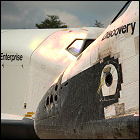 Having completed its last mission, Space Shuttle Discovery is retired, stripped of working engine parts and other items, and donated to the Smithsonian Air & Space Museum by NASA. The workhorse of the shuttle fleet, Discovery flew in space 39 times starting in 1984, visiting both Mir and the International Space Station, and racking up a cumulative total of an entire year in orbit. Discovery takes the place of the test orbiter, Enterprise, which has been on display at the Smithsonian since the 1980s.
Having completed its last mission, Space Shuttle Discovery is retired, stripped of working engine parts and other items, and donated to the Smithsonian Air & Space Museum by NASA. The workhorse of the shuttle fleet, Discovery flew in space 39 times starting in 1984, visiting both Mir and the International Space Station, and racking up a cumulative total of an entire year in orbit. Discovery takes the place of the test orbiter, Enterprise, which has been on display at the Smithsonian since the 1980s.
Retirement homes for Space Shuttles
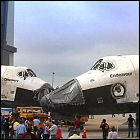 NASA announces the results of a bidding process for soon-to-be-retired Space Shuttle vehicles by institutions across the country. The original test vehicle, Enterprise, will be removed from the Smithsonian and replaced by the space-flown Discovery, while Atlantis will become the centerpiece of a new exhibit at NASA’s own Kennedy Space Center. Endeavour will be handed over to the California Science Museum in Los Angeles, while Enterprise’s new home will be in New York City’s Intrepid Museum. Institutions not selected to receive one of the shuttles, including NASA’s Johnson Space Center in Houston, Texas, almost immediately claim that the selection process has been swayed by politics. None of the vehicles will be transported from Kennedy Space Center to their new locations until the following year.
NASA announces the results of a bidding process for soon-to-be-retired Space Shuttle vehicles by institutions across the country. The original test vehicle, Enterprise, will be removed from the Smithsonian and replaced by the space-flown Discovery, while Atlantis will become the centerpiece of a new exhibit at NASA’s own Kennedy Space Center. Endeavour will be handed over to the California Science Museum in Los Angeles, while Enterprise’s new home will be in New York City’s Intrepid Museum. Institutions not selected to receive one of the shuttles, including NASA’s Johnson Space Center in Houston, Texas, almost immediately claim that the selection process has been swayed by politics. None of the vehicles will be transported from Kennedy Space Center to their new locations until the following year.
STS-133: Discovery’s final flight
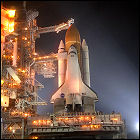 Space Shuttle Discovery lifts off on the 133rd shuttle flight, a 13-day mission add a new (but familiar) module to the International Space Station. One of the logistics modules that has flown in the cargo bay of seven prior shuttle missions is attached to the ISS permanently, adding nearly 2,500 cubic feet of storage space to the facility. Also delivered to the station is Robonaut 2, an experimental robot designed to assist with routine tasks as well as spacewalks. Discovery’s 39th and final crew is Commander Steve Lindsey, Pilot Eric Boe, and mission specialists Alvin Drew, Nicole Stott, Steve Bowen and Michael Barratt.
Space Shuttle Discovery lifts off on the 133rd shuttle flight, a 13-day mission add a new (but familiar) module to the International Space Station. One of the logistics modules that has flown in the cargo bay of seven prior shuttle missions is attached to the ISS permanently, adding nearly 2,500 cubic feet of storage space to the facility. Also delivered to the station is Robonaut 2, an experimental robot designed to assist with routine tasks as well as spacewalks. Discovery’s 39th and final crew is Commander Steve Lindsey, Pilot Eric Boe, and mission specialists Alvin Drew, Nicole Stott, Steve Bowen and Michael Barratt.
STS-131
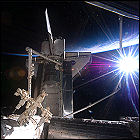 Space Shuttle Discovery is launched on the 131st shuttle flight, a 15-day resupply mission to the International Space Station. Equipment and experiment packages are transferred to the station from a logistics module in the shuttle cargo bay. The joint portion of the flight features the largest female astronaut contingent in orbit at any one time to date, with three of Discovery’s six crewmembers plus station astronaut Tracy Dyson. Aboard Discovery for her 38th flight are Commander Alan Poindexter, Pilot James Dutton, and mission specialists Dorothy Metcalf-Lindenburger, Rick Mastracchio, Naoko Yamazaki, Clayton Anderson and Stephanie Wilson.
Space Shuttle Discovery is launched on the 131st shuttle flight, a 15-day resupply mission to the International Space Station. Equipment and experiment packages are transferred to the station from a logistics module in the shuttle cargo bay. The joint portion of the flight features the largest female astronaut contingent in orbit at any one time to date, with three of Discovery’s six crewmembers plus station astronaut Tracy Dyson. Aboard Discovery for her 38th flight are Commander Alan Poindexter, Pilot James Dutton, and mission specialists Dorothy Metcalf-Lindenburger, Rick Mastracchio, Naoko Yamazaki, Clayton Anderson and Stephanie Wilson.
STS-128
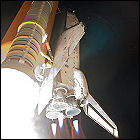 Space Shuttle Discovery lifts off on the 128th shuttle flight, a two-week mission to the International Space Station. Supplies and equipment are delivered to the space station in a cargo-bay-mounted logistics module. Aboard Discovery for her 37th flight are Commander Rick Sturckow, Pilot Kevin Ford, and mission specialists Jose Hernandez, Danny Olivas, Nicole Stott, Christer Fuglesang and Patrick Forrester. Stott remains on the International Space Station, while station crewmember Timothy Kopra returns to Earth aboard the shuttle.
Space Shuttle Discovery lifts off on the 128th shuttle flight, a two-week mission to the International Space Station. Supplies and equipment are delivered to the space station in a cargo-bay-mounted logistics module. Aboard Discovery for her 37th flight are Commander Rick Sturckow, Pilot Kevin Ford, and mission specialists Jose Hernandez, Danny Olivas, Nicole Stott, Christer Fuglesang and Patrick Forrester. Stott remains on the International Space Station, while station crewmember Timothy Kopra returns to Earth aboard the shuttle.
STS-119
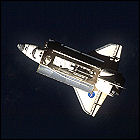 Space Shuttle Discovery lifts off on the 125th shuttle flight, a 13-day mission to the International Space Station. Further spacewalks to repair the station’s solar arrays are conducted, as well as a repair to its on-board water system; with the power and water issues resolved, the station can now house a crew of six astronauts and cosmonauts. Aboard Discovery for her 36th flight are Commander Lee Archambault, Pilot Tony Antonelli, and mission specialists Joseph Acaba, Steve Swanson, Richard Arnold, John Phillips and Koichi Wakata. Wakata stays aboard the station, while ISS crewmember Sandra Magnus returns to Earth aboard Discovery.
Space Shuttle Discovery lifts off on the 125th shuttle flight, a 13-day mission to the International Space Station. Further spacewalks to repair the station’s solar arrays are conducted, as well as a repair to its on-board water system; with the power and water issues resolved, the station can now house a crew of six astronauts and cosmonauts. Aboard Discovery for her 36th flight are Commander Lee Archambault, Pilot Tony Antonelli, and mission specialists Joseph Acaba, Steve Swanson, Richard Arnold, John Phillips and Koichi Wakata. Wakata stays aboard the station, while ISS crewmember Sandra Magnus returns to Earth aboard Discovery.
STS-124
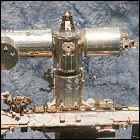 Space Shuttle Discovery is launched on the 123rd shuttle flight, a two-week mission to install a major laboratory module to the International Space Station. The pressurized module of Japan’s Kibo laboratory joins the unpressurized section installed on a previous flight, complete with its own robotic arm controlled inside. Aboard Discovery for her 35th flight are Commander Mark Kelly, Pilot Ken Ham, mission specialists Karen Nyberg, Ron Garan and Mike Fossum, and Japanese astronaut Akihiko Hoshide, who remains on the International Space Station. Station astronaut Garrett Reisman returns to Earth aboard Discovery.
Space Shuttle Discovery is launched on the 123rd shuttle flight, a two-week mission to install a major laboratory module to the International Space Station. The pressurized module of Japan’s Kibo laboratory joins the unpressurized section installed on a previous flight, complete with its own robotic arm controlled inside. Aboard Discovery for her 35th flight are Commander Mark Kelly, Pilot Ken Ham, mission specialists Karen Nyberg, Ron Garan and Mike Fossum, and Japanese astronaut Akihiko Hoshide, who remains on the International Space Station. Station astronaut Garrett Reisman returns to Earth aboard Discovery.
STS-116
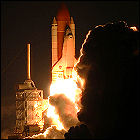 Space Shuttle Discovery returns to the International Space Station to add another major structural truss, resupply the station, and swap crew members. During this flight, the 75th spacewalk involving station construction takes place, moving part of the station’s solar power apparatus to another part of the station. Aboard Discovery for this flight are Commander Mark Polansky, Pilot William Oefelein, and mission specialists Robert Curbeam, Joan Higginbotham, Nicholas Patrick, Christer Fuglesang and Sunita Williams, who will stay on the International Space Station as its new flight engineer. Returning with Discovery is Thomas Reiter, who was flown to the station aboard Discovery in July.
Space Shuttle Discovery returns to the International Space Station to add another major structural truss, resupply the station, and swap crew members. During this flight, the 75th spacewalk involving station construction takes place, moving part of the station’s solar power apparatus to another part of the station. Aboard Discovery for this flight are Commander Mark Polansky, Pilot William Oefelein, and mission specialists Robert Curbeam, Joan Higginbotham, Nicholas Patrick, Christer Fuglesang and Sunita Williams, who will stay on the International Space Station as its new flight engineer. Returning with Discovery is Thomas Reiter, who was flown to the station aboard Discovery in July.
STS-121
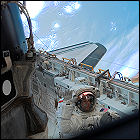 NASA launches Space Shuttle Discovery for the first time in nearly a year for a second “Return to Flight” mission to the International Space Station, testing more safety procedures and new materials developed since the July 2005 flight (which still required repairs to be conducted in orbit). Aboard Discovery are Commander Steven Lindsey, Pilot Mark Kelly, and mission specialists Stephanie Wilson, Michael Fossum, Piers Sellers, Thomas Reiter and Lisa Nowak. Reiter remains aboard the station, bumping its crew up to three people for the first time since 2003.
NASA launches Space Shuttle Discovery for the first time in nearly a year for a second “Return to Flight” mission to the International Space Station, testing more safety procedures and new materials developed since the July 2005 flight (which still required repairs to be conducted in orbit). Aboard Discovery are Commander Steven Lindsey, Pilot Mark Kelly, and mission specialists Stephanie Wilson, Michael Fossum, Piers Sellers, Thomas Reiter and Lisa Nowak. Reiter remains aboard the station, bumping its crew up to three people for the first time since 2003.
STS-114
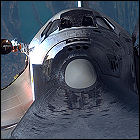 Space Shuttle Discovery lifts off on the first shuttle mission in over two years (and the first since the Columbia disaster) on a mission to resupply the International Space Station. Before docking at the station, Discovery performs the first Rendezvous Pitch Maneuver, a shuttle somersault devised by mission planners to allow the space station crew to extensively photograph the shuttle’s thermal tiles to identify areas of concern. As it turns out, some tile repairs are conducted on this mission before the shuttle can return home. Aboard Discovery for this flight are Commander Eileen Collins, Pilot James Kelly, and mission specialists Charles Camarda, Wendy Lawrence, Soichi Noguchi, Stephen Robinson and Andrew Thomas.
Space Shuttle Discovery lifts off on the first shuttle mission in over two years (and the first since the Columbia disaster) on a mission to resupply the International Space Station. Before docking at the station, Discovery performs the first Rendezvous Pitch Maneuver, a shuttle somersault devised by mission planners to allow the space station crew to extensively photograph the shuttle’s thermal tiles to identify areas of concern. As it turns out, some tile repairs are conducted on this mission before the shuttle can return home. Aboard Discovery for this flight are Commander Eileen Collins, Pilot James Kelly, and mission specialists Charles Camarda, Wendy Lawrence, Soichi Noguchi, Stephen Robinson and Andrew Thomas.
STS-105 / ISS Expedition 3
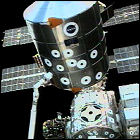 Space Shuttle Discovery lifts off on the 106th shuttle flight, a mission to exchange crews aboard the International Space Station. The shuttle’s cargo bay carries a logistics module containing more equipment for the ISS laboratory module, as well as storage racks to be installed elsewhere in the station. Aboard Discovery for her 30th flight are Commander Scott Horowitz, Pilot Frederick Sturckow, missions specialists Daniel Barry and Patrick Forrester, and ISS Expedition 3 crewmembers Frank Culbertson, Mikhail Turin and Vladimir Dezhurov, who remain aboard the station. Returning to Earth via Discovery are ISS Expedition 2 crewmembers Yury Usachev, James Voss and Susan Helms.
Space Shuttle Discovery lifts off on the 106th shuttle flight, a mission to exchange crews aboard the International Space Station. The shuttle’s cargo bay carries a logistics module containing more equipment for the ISS laboratory module, as well as storage racks to be installed elsewhere in the station. Aboard Discovery for her 30th flight are Commander Scott Horowitz, Pilot Frederick Sturckow, missions specialists Daniel Barry and Patrick Forrester, and ISS Expedition 3 crewmembers Frank Culbertson, Mikhail Turin and Vladimir Dezhurov, who remain aboard the station. Returning to Earth via Discovery are ISS Expedition 2 crewmembers Yury Usachev, James Voss and Susan Helms.
STS-102 / ISS Expedition 2
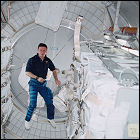 Space Shuttle Discovery lifts off on the 103rd shuttle flight, a mission to exchange crewmembers aboard the International Space Station. In the cargo bay is a logistics module containing consumables, supplies, and equipment racks to be installed in the Destiny laboratory module. Aboard Discovery for her 29th flight are Commander James Wetherbee, Pilot James Kelly, mission specialists Andrew Thomas and Paul Richards, and ISS Expedition 2 crewmembers James Voss, Susan Helms and Yuriy Usachev. The Expedition 1 crewmembers (William Shepherd, Yuri Gidzenko and Sergei Krikalev) return to Earth aboard the shuttle.
Space Shuttle Discovery lifts off on the 103rd shuttle flight, a mission to exchange crewmembers aboard the International Space Station. In the cargo bay is a logistics module containing consumables, supplies, and equipment racks to be installed in the Destiny laboratory module. Aboard Discovery for her 29th flight are Commander James Wetherbee, Pilot James Kelly, mission specialists Andrew Thomas and Paul Richards, and ISS Expedition 2 crewmembers James Voss, Susan Helms and Yuriy Usachev. The Expedition 1 crewmembers (William Shepherd, Yuri Gidzenko and Sergei Krikalev) return to Earth aboard the shuttle.
STS-92: opening the ISS for business
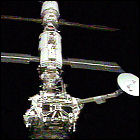 On the 100th flight of the American shuttle program, Space Shuttle Discovery pays a 13-day visit to the International Space Station, making final preparations before the station’s first crew arrives. A new shuttle docking port is added, and the first section of external truss is bolted onto the station, the beginning of a structure that will support the larger solar power panels to be installed during later construction missions. Discovery’s 28th crew is Commander Brian Duffy, Pilot Pam Melroy, and mission specialists Koichi Wakata, Leroy Chiao, Peter Wisoff, Michael Lopez-Alegria and William McArthur.
On the 100th flight of the American shuttle program, Space Shuttle Discovery pays a 13-day visit to the International Space Station, making final preparations before the station’s first crew arrives. A new shuttle docking port is added, and the first section of external truss is bolted onto the station, the beginning of a structure that will support the larger solar power panels to be installed during later construction missions. Discovery’s 28th crew is Commander Brian Duffy, Pilot Pam Melroy, and mission specialists Koichi Wakata, Leroy Chiao, Peter Wisoff, Michael Lopez-Alegria and William McArthur.
STS-103: return to Hubble
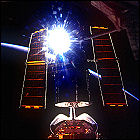 Space Shuttle Discovery lifts off on an eight-day mission to retrieve, service and redeploy the Hubble Space Telescope. This routine planned upgrade for Hubble sees the shuttle crew swapping out the $2,000,000,000 telescope’s CPU, installing a new one with 20 times the processing power of the original, during an eight-hour spacewalk; another eight-hour spacewalk sees crewmembers removing an analog data recorder to replace it with a digital device with greater capacity. Christmas 1999 is spent placing Hubble back into its orbit. Aboard Discovery for her 27th flight are Commander Curtis Brown, Pilot Scott Kelly, and mission specialists Steven Smith, Michael Foale, John Grunsfield, Claude Nicollier and Jean-Francois Clervoy.
Space Shuttle Discovery lifts off on an eight-day mission to retrieve, service and redeploy the Hubble Space Telescope. This routine planned upgrade for Hubble sees the shuttle crew swapping out the $2,000,000,000 telescope’s CPU, installing a new one with 20 times the processing power of the original, during an eight-hour spacewalk; another eight-hour spacewalk sees crewmembers removing an analog data recorder to replace it with a digital device with greater capacity. Christmas 1999 is spent placing Hubble back into its orbit. Aboard Discovery for her 27th flight are Commander Curtis Brown, Pilot Scott Kelly, and mission specialists Steven Smith, Michael Foale, John Grunsfield, Claude Nicollier and Jean-Francois Clervoy.
STS-96: ISS under construction
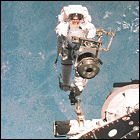 NASA launches Space Shuttle Discovery on the first of only three 1999 shuttle flights, a ten-day mission to continue preparing the International Space Station for full-time duty. 80 hours are spent inside the station, transferring supplies into the existing modules for future crews, and spacewalks are conducted to perform necessary tasks outside the station. Aboard Discovery for her 26th flight are Commander Kent Rominger, Pilot Rick Husband, and mission specialists Ellen Ochoa, Tammy Jernigan, Daniel Barry, Julie Payette and Valery Tokarev.
NASA launches Space Shuttle Discovery on the first of only three 1999 shuttle flights, a ten-day mission to continue preparing the International Space Station for full-time duty. 80 hours are spent inside the station, transferring supplies into the existing modules for future crews, and spacewalks are conducted to perform necessary tasks outside the station. Aboard Discovery for her 26th flight are Commander Kent Rominger, Pilot Rick Husband, and mission specialists Ellen Ochoa, Tammy Jernigan, Daniel Barry, Julie Payette and Valery Tokarev.
STS-95: John Glenn returns to space
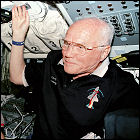 The first American to orbit Earth returns to orbit aboard Space Shuttle Discovery. During a ten-day mission with the SPACEHAB laboratory module installed in the cargo bay, the crew conducts medical experiments with Mercury astronaut John Glenn, comparing his results against the results of identical experiments performed with one of his crewmates, to determine the effect of weightlessness on older space travelers. At the age of 77, Glenn is the world’s oldest space traveler (and is still a sitting member of the U.S. Senate at the time of his flight). Discovery’s crew on her 25th flight is Commander Curtis Brown, Pilot Steven Lindsey, mission specialists Scott Parazynski, Stephen Robinson and Pedro Duque, and payload specialists Chiaki Mukai and John Glenn.
The first American to orbit Earth returns to orbit aboard Space Shuttle Discovery. During a ten-day mission with the SPACEHAB laboratory module installed in the cargo bay, the crew conducts medical experiments with Mercury astronaut John Glenn, comparing his results against the results of identical experiments performed with one of his crewmates, to determine the effect of weightlessness on older space travelers. At the age of 77, Glenn is the world’s oldest space traveler (and is still a sitting member of the U.S. Senate at the time of his flight). Discovery’s crew on her 25th flight is Commander Curtis Brown, Pilot Steven Lindsey, mission specialists Scott Parazynski, Stephen Robinson and Pedro Duque, and payload specialists Chiaki Mukai and John Glenn.
STS-91: last stop at Mir
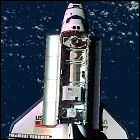 Space Shuttle Discovery becomes the last American shuttle to visit space station Mir during a ten-day mission launched on this date. The historic mission is marred slightly by a communications malfunction which makes live TV transmissions from orbit impossible. In addition to retrieving American science experiment packages from Mir, a cargo-bay-mounted experiment to detect dark matter is also conducted. Supplies are also off-loaded onto Mir. Aboard Discovery for her 24th flight are Commander Charles Precourt, Pilot Dominic Gorie, and mission specialists Wendy Lawrence, Franklin Chang-Diaz, Janet Kavandi and Valery Ryumin. Mir astronaut Andrew Thomas, the last American to visit the Russian station, returns to Earth aboard Discovery.
Space Shuttle Discovery becomes the last American shuttle to visit space station Mir during a ten-day mission launched on this date. The historic mission is marred slightly by a communications malfunction which makes live TV transmissions from orbit impossible. In addition to retrieving American science experiment packages from Mir, a cargo-bay-mounted experiment to detect dark matter is also conducted. Supplies are also off-loaded onto Mir. Aboard Discovery for her 24th flight are Commander Charles Precourt, Pilot Dominic Gorie, and mission specialists Wendy Lawrence, Franklin Chang-Diaz, Janet Kavandi and Valery Ryumin. Mir astronaut Andrew Thomas, the last American to visit the Russian station, returns to Earth aboard Discovery.
STS-85
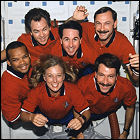 NASA launches Space Shuttle Discovery on the 86th shuttle flight, a 12-day mission to deploy a spectroscopy experiment and practice spacewalking construction techniques vital to the upcoming early missions to build the International Space Station. Aboard Discovery for her 23rd flight are Commander Curtis Brown, Pilot Kent Rominger, mission specialists Jan Davis, Robert Curbeam and Stephen Robinson, and payload specialist Bjarni Tryggvason.
NASA launches Space Shuttle Discovery on the 86th shuttle flight, a 12-day mission to deploy a spectroscopy experiment and practice spacewalking construction techniques vital to the upcoming early missions to build the International Space Station. Aboard Discovery for her 23rd flight are Commander Curtis Brown, Pilot Kent Rominger, mission specialists Jan Davis, Robert Curbeam and Stephen Robinson, and payload specialist Bjarni Tryggvason.
STS-82: back to Hubble
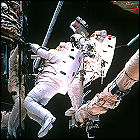 Space Shuttle Discovery lifts off on a ten-day mission to service the Hubble Space Telescope. Over 30 hours of spacewalks are conducted to repair and upgrade Hubble with new parts, and the shuttle engines are fired in short, steady bursts to raise the telescope’s orbit by over eight miles before it is released again. Aboard Discovery on her 22nd flight are Commander Kenneth Bowersox, Pilot Scott Horowitz, and mission specialists Mark Lee, Steven Hawley, Gregory Harbaugh, Steven Smith and Joseph Tanner.
Space Shuttle Discovery lifts off on a ten-day mission to service the Hubble Space Telescope. Over 30 hours of spacewalks are conducted to repair and upgrade Hubble with new parts, and the shuttle engines are fired in short, steady bursts to raise the telescope’s orbit by over eight miles before it is released again. Aboard Discovery on her 22nd flight are Commander Kenneth Bowersox, Pilot Scott Horowitz, and mission specialists Mark Lee, Steven Hawley, Gregory Harbaugh, Steven Smith and Joseph Tanner.
STS-70
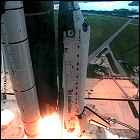 Space Shuttle Discovery lifts off on the 70th shuttle flight, a nine-day mission to deploy a TDRS (Tracking & Data Relay Satellite) for NASA. The flight has seen many delays, including repairs made necessary by woodpeckers poking holes in the shuttle’s external fuel tank! The crew – consisting of Commander Terence Henricks, Pilot Kevin Kregel, and mission specialists Nancy Jane Currie, Donald Thomas and Mary Ellen Weber – conducts material and medical experiments after the deployment of the final satellite in the TDRS constellation.
Space Shuttle Discovery lifts off on the 70th shuttle flight, a nine-day mission to deploy a TDRS (Tracking & Data Relay Satellite) for NASA. The flight has seen many delays, including repairs made necessary by woodpeckers poking holes in the shuttle’s external fuel tank! The crew – consisting of Commander Terence Henricks, Pilot Kevin Kregel, and mission specialists Nancy Jane Currie, Donald Thomas and Mary Ellen Weber – conducts material and medical experiments after the deployment of the final satellite in the TDRS constellation.
STS-63: the shuttle visits Mir
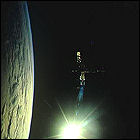 Space Shuttle Discovery lifts off on the 67th flight of the shuttle program, a history-making mission that sees Discovery conducting rendezvous maneuvers at the Russian space station Mir. Though the shuttle isn’t equipped to dock at Mir, the close flyby is a necessary step before a docking mission can take place, and Discovery’s crew includes a former Mir cosmonaut. The crew for this flight is Commander James Wetherbee, Pilot Eileen M. Collins, and mission Specialists Michael Foale, Janice Voss, Bernard Harris and Vladimar Titov.
Space Shuttle Discovery lifts off on the 67th flight of the shuttle program, a history-making mission that sees Discovery conducting rendezvous maneuvers at the Russian space station Mir. Though the shuttle isn’t equipped to dock at Mir, the close flyby is a necessary step before a docking mission can take place, and Discovery’s crew includes a former Mir cosmonaut. The crew for this flight is Commander James Wetherbee, Pilot Eileen M. Collins, and mission Specialists Michael Foale, Janice Voss, Bernard Harris and Vladimar Titov.
STS-64
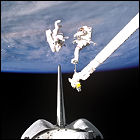 NASA launches Space Shuttle Discovery on the 64th flight of the shuttle program. The cargo bay carries an experiment to test LIDAR applications from orbit, and is the site of a six-hour spacewalk to test an alternative to the retired MMU “jet pack” for EVA rescue purposes. Aboard Discovery for her 19th mission are Commander Richard Richards, Pilot Blaine Hammond, and mission specialists Jerry Linenger, Susan Helms, Carl Meade and Mark Lee.
NASA launches Space Shuttle Discovery on the 64th flight of the shuttle program. The cargo bay carries an experiment to test LIDAR applications from orbit, and is the site of a six-hour spacewalk to test an alternative to the retired MMU “jet pack” for EVA rescue purposes. Aboard Discovery for her 19th mission are Commander Richard Richards, Pilot Blaine Hammond, and mission specialists Jerry Linenger, Susan Helms, Carl Meade and Mark Lee.
STS-60
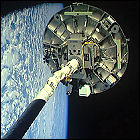 Space Shuttle Discovery lifts off on the 60th flight of the shuttle program. During its eight days in orbit, Discovery hosts the first Russian cosmonaut ever to fly aboard an American spacecraft, initiating an ongoing agreement between the two countries’ space agencies that will eventually lead to shuttles visiting Mir and the construction of the International Space Station. Aboard Discovery for her 18th flight are Commander Charles Bolden, Pilot Kenneth Reightler, and mission specialists Jan Davis, Ronald Sega, Franklin Chang-Diaz and Sergei Krikalev.
Space Shuttle Discovery lifts off on the 60th flight of the shuttle program. During its eight days in orbit, Discovery hosts the first Russian cosmonaut ever to fly aboard an American spacecraft, initiating an ongoing agreement between the two countries’ space agencies that will eventually lead to shuttles visiting Mir and the construction of the International Space Station. Aboard Discovery for her 18th flight are Commander Charles Bolden, Pilot Kenneth Reightler, and mission specialists Jan Davis, Ronald Sega, Franklin Chang-Diaz and Sergei Krikalev.
STS-51
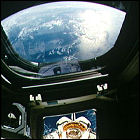 Space Shuttle Discovery lifts off on the 57th shuttle mission, a nine-day stay in orbit to release a communications satellite and test a new second stage engine designed to push that satellite into geosynchronous orbit. A free-floating ultraviolet spectography experiment is released from the shuttle’s cargo bay and retrieved before the end of the mission, and spacewalking techniques for the upcoming Hubble Space Telescope repair mission are practiced. Aboard Discovery for her 17th flight are Commander Frank Culbertson Jr., Pilot William Readdy, and mission specialists James Newman, Daniel Bursch and Carl Walz.
Space Shuttle Discovery lifts off on the 57th shuttle mission, a nine-day stay in orbit to release a communications satellite and test a new second stage engine designed to push that satellite into geosynchronous orbit. A free-floating ultraviolet spectography experiment is released from the shuttle’s cargo bay and retrieved before the end of the mission, and spacewalking techniques for the upcoming Hubble Space Telescope repair mission are practiced. Aboard Discovery for her 17th flight are Commander Frank Culbertson Jr., Pilot William Readdy, and mission specialists James Newman, Daniel Bursch and Carl Walz.
STS-56
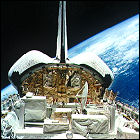 Space Shuttle Discovery lifts off with the ATLAS-2 scientific payload for a nine-day mission. A free-floating platform to measure solar wind activity is also deployed and then retrieved before returning to Earth. Aboard Discovery for her 16th flight are Commander Kenneth Cameron, Pilot Stephen Oswald, and mission specialists Michael Foale, Kenneth Cockrell and Ellen Ochoa.
Space Shuttle Discovery lifts off with the ATLAS-2 scientific payload for a nine-day mission. A free-floating platform to measure solar wind activity is also deployed and then retrieved before returning to Earth. Aboard Discovery for her 16th flight are Commander Kenneth Cameron, Pilot Stephen Oswald, and mission specialists Michael Foale, Kenneth Cockrell and Ellen Ochoa.
STS-53
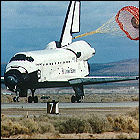 Space Shuttle Discovery lifts off on the 52nd shuttle flight, a seven-day mission to deploy a classified Department of Defense payload and conduct various science experiments within the shuttle itself. Flying Discovery on its 15th launch are Commander David Walker, Pilot Robert Cabana, and mission specialists Guion Bluford, James Voss and Michael Clifford.
Space Shuttle Discovery lifts off on the 52nd shuttle flight, a seven-day mission to deploy a classified Department of Defense payload and conduct various science experiments within the shuttle itself. Flying Discovery on its 15th launch are Commander David Walker, Pilot Robert Cabana, and mission specialists Guion Bluford, James Voss and Michael Clifford.
STS-42
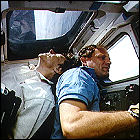 Space Shuttle Discovery lifts off for an eight day Spacelab mission, with an multi-national crew participating in “IML-1” (International Microgravity Laboratory) experiments. Discovery’s crew for this flight consists of Commander Ronald Grabe, Pilot Stephen Oswald, mission specialists Norman Thagard, David Hilmers, and William Readdy, and payload specialists Roberta Bondar and Ulf Merbold.
Space Shuttle Discovery lifts off for an eight day Spacelab mission, with an multi-national crew participating in “IML-1” (International Microgravity Laboratory) experiments. Discovery’s crew for this flight consists of Commander Ronald Grabe, Pilot Stephen Oswald, mission specialists Norman Thagard, David Hilmers, and William Readdy, and payload specialists Roberta Bondar and Ulf Merbold.
STS-48
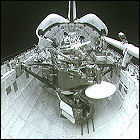 Space Shuttle Discovery lifts off on a five-day mission to deliver the Upper Atmosphere Research Satellite (UARS) into a low Earth orbit, where the satellite spends over a year studying the outer layers of Earth’s atmosphere. UARS also focuses on study of Earth’s ozone layer. Other experiments are carried out aboard the orbiter by Commander John Creighton, Pilot Kenneth Reightler, , and mission specialists Mark Brown, Charles Gemar and James Buchli.
Space Shuttle Discovery lifts off on a five-day mission to deliver the Upper Atmosphere Research Satellite (UARS) into a low Earth orbit, where the satellite spends over a year studying the outer layers of Earth’s atmosphere. UARS also focuses on study of Earth’s ozone layer. Other experiments are carried out aboard the orbiter by Commander John Creighton, Pilot Kenneth Reightler, , and mission specialists Mark Brown, Charles Gemar and James Buchli.
STS-39
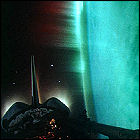 Space Shuttle Discovery lifts off on an eight-day mission to delivery both classified and unclassified Defense Department payloads into Earth orbit. Aboard the shuttle for this flight are Commander Michael Coats, Pilot Blaine Hammond, and mission specialists Guion Bluford, Gregory Harbaugh, Richard Hieb, Donald McMonagle and Charles Veach.
Space Shuttle Discovery lifts off on an eight-day mission to delivery both classified and unclassified Defense Department payloads into Earth orbit. Aboard the shuttle for this flight are Commander Michael Coats, Pilot Blaine Hammond, and mission specialists Guion Bluford, Gregory Harbaugh, Richard Hieb, Donald McMonagle and Charles Veach.
STS-41
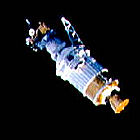 Space Shuttle Discovery lifts off to deliver another space probe whose launch has been delayed in recent years, the Ulysses mission. The remnant of a more elaborate (but ultimately scrapped) International Solar Polar mission, Ulysses is the first and only shuttle payload to use a two-stage booster to launch it from Earth orbit into a high, looping trajectory out of the plane of the ecliptic (roughly corresponding to the sun’s equator, around which the solar system’s planets orbit). Ulysses, built and managed by the European Space Agency, promises the first views of the sun’s polar regions. Discovery’s crew is Commander Richard N. Richards, Pilot Robert Cabana, and mission specialists William Shepherd, Bruce Melnick and Thomas Akers. Discovery lands at Edwards Air Force Base after four days in orbit.
Space Shuttle Discovery lifts off to deliver another space probe whose launch has been delayed in recent years, the Ulysses mission. The remnant of a more elaborate (but ultimately scrapped) International Solar Polar mission, Ulysses is the first and only shuttle payload to use a two-stage booster to launch it from Earth orbit into a high, looping trajectory out of the plane of the ecliptic (roughly corresponding to the sun’s equator, around which the solar system’s planets orbit). Ulysses, built and managed by the European Space Agency, promises the first views of the sun’s polar regions. Discovery’s crew is Commander Richard N. Richards, Pilot Robert Cabana, and mission specialists William Shepherd, Bruce Melnick and Thomas Akers. Discovery lands at Edwards Air Force Base after four days in orbit.